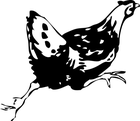Shanghai Street View: Bird Flu Takes Flight

What a difference a year makes. Many of us have been out and about these last couple of weeks enjoying the springtime weather, taking in cherry blossoms and celebrating the end of winter. Amid the spring fever, few people seem to recall that Shanghai at this time last year was a far different place, gripped by fear as the new and unknown H7N9 strain of bird flu swept through the city.
The dramatic difference between last year and this one is a strong testament to the power of education, and also to the city’s strong actions to avoid another outbreak. The cycle looks quite similar to what happened exactly a decade ago with SARS, which created an even bigger panic in Hong Kong where I was living at the time, only to disappear the following year.
Despite a steady stream of new H7N9 bird flu cases at the start of the year, a look through the latest headlines reveals a striking absence of such news in recent weeks.
My review of headlines from one of the city’s main newspapers found just 2 headlines on the topic so far this month, including one saying that 24 people died from the virus in March throughout China, a tiny fraction of the 560,000 people who caught contagious diseases during the month. The other headline was even more benign, reporting on a possible vaccination being developed in Hong Kong for a virus that sickened 132 and killed about a quarter of those it infected last year.
A review of the headlines from this time last year was far different, revealing a Shanghai in a state of near panic. As someone who follows business news closely, I watched at that time as companies like auto parts maker Delphi postponed a major conference scheduled in the city during that time due to concerns about an epidemic. Similar fears led to major losses for many of the city’s hotels and restaurants, as business travelers and tourists avoided the city.
The biggest headline grabber in the corporate world was KFC (NYSE: YUM), which put out a steady stream of gloomy headlines as consumers avoided its restaurants over baseless fears that they could catch H7N9 from eating cooked chicken. KFC same-store sales tumbled 36 percent last April at the height of the scare, before rebounding somewhat as the outbreak eased.
Those headline figures were depressing enough, but what was truly depressing was an actual trip to a KFC. As a chicken lover, I made a few such trips at that time and recall how most KFCs were nearly empty. Even the few people who were inside carefully avoided ordering any chicken dishes. Poultry also evaporated from the menus at other restaurants, and I had to wait until late May until my favorite Cantonese restaurant started serving roast chicken again.
Last year’s panic, followed by a case of amnesia this year, is strikingly similar to what happened during the SARS scare that swept through Hong Kong exactly a decade earlier. In that instance, Hong Kong became gripped with fear in March and April of 2003 as the strange and unknown disease infected nearly 2,000 people, killing more than 10 percent of those who got sick.
Popular shopping and dining destinations like Causeway Bay suddenly became deserted, and everyone started wearing surgical masks and stopped shaking hands over fears of catching the disease. Anyone unfortunate enough to get a common cold at that time was immediately viewed with suspicion, and a simple cough could send nearby people running for cover. Everyone waited anxiously to see if SARS would reappear in during flu season of 2004. But those fears quickly evaporated when SARS failed to make an encore appearance, and the disease was all but forgotten after that.
The failure of H7N9 to make a similar encore appearance owes to many of the same factors that wiped out SARS. One of the biggest of those was simply education. In both cases, the newness of the disease and its initially high mortality rates were the biggest source of concern when it first appeared.
Shanghai’s smartest move this year was its early decision to shut down all the city’s live poultry markets at Chinese New Year, and to keep them closed until after the flu season ends in May and June. I’ve previously said the city should consider a permanent ban on live poultry sales, though more traditional residents insist that live birds are tastier than ones killed in more sanitary slaughterhouses.
At the end of the day, it does seem like the current approach is a good compromise that has helped to erase H7N9 bird flu from the headlines this year, and hopefully for many more years to come.
